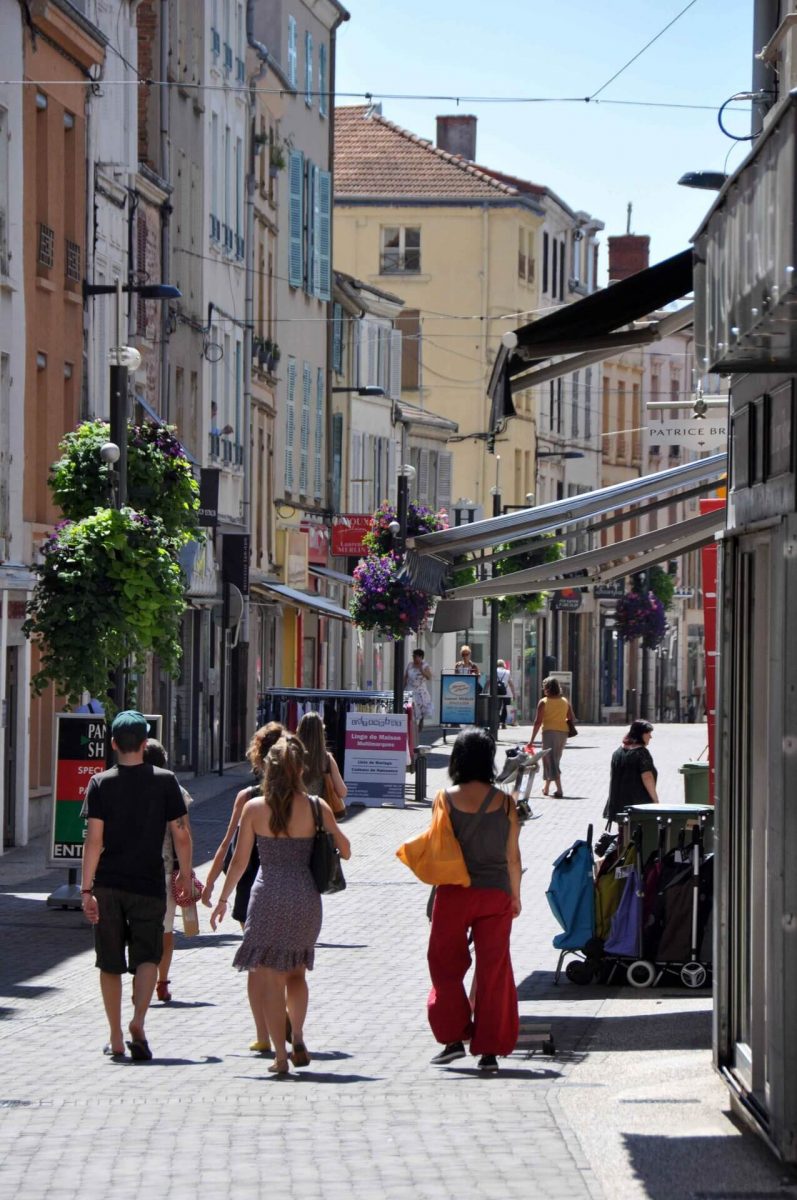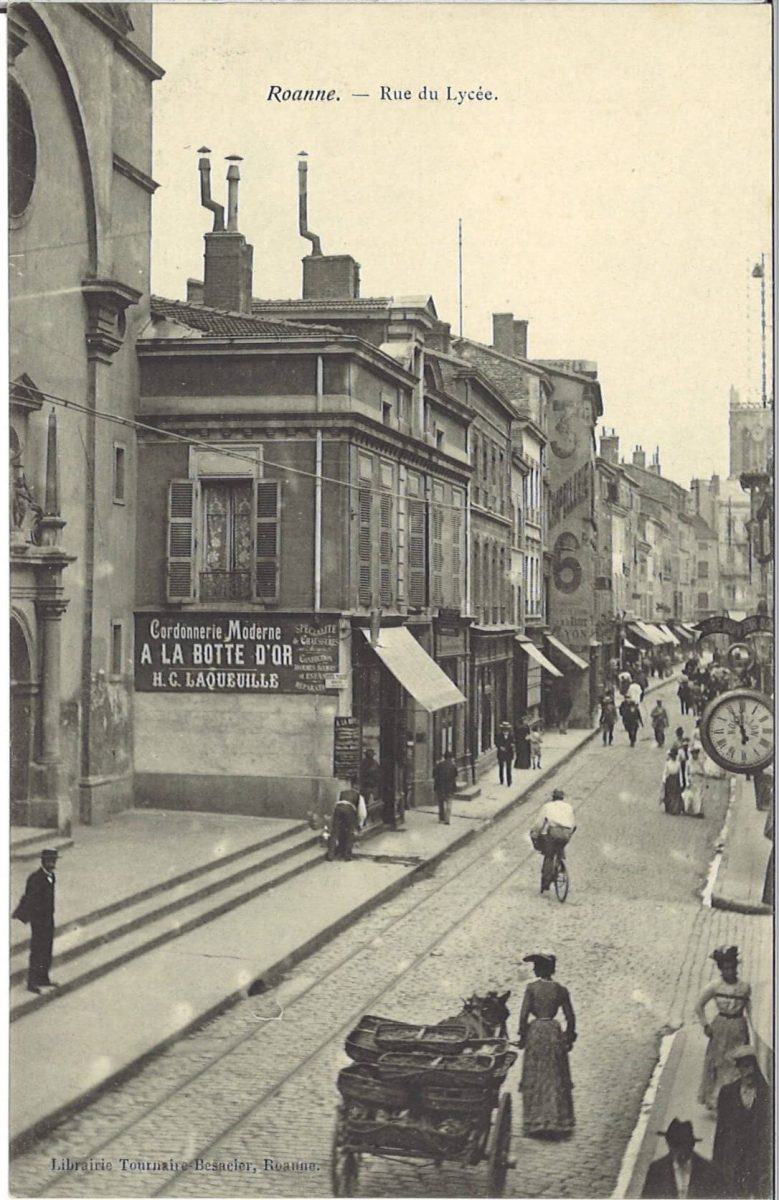Who does not know the pedestrian streets of Roanne? These two streets in the city center are the essentials of a Roanne shopping spree. Look up to admire the beautiful mansions of these streets and all the traces of the past.
This old path which leads from the castle to the port has always been the main artery of the city. Until very recently the rue Charles de Gaulle provided the passage between the road to Paris and that of Lyon. This situation quickly made it a "business" district and businesses developed!
Today, when we talk about pedestrian streets in Roanne, they are rue Charles de Gaulle and rue Maréchal Foch.

Pedestrian streets, a place of life in Roanne
Do you fancy shopping in the city center? The pedestrian streets are the city's must-sees, like an open-air commercial space. There is something for all tastes and desires: so-called chain stores (Pimkie, Armand Thiery, Bréal…) or small independent clothing stores for women, men and children. Your gourmet desires will be satisfied with renowned pastries or chocolate shops:
- Bertrand chocolatier and its domes,
- François Pralus and his Pralulin®,
- Revillon and its curls.
You can sip a small drink on the terrace by the rue Charles de Gaulle fountain.
Local commerce is very important if we are to believe the regular opening of new stores: clothing, telephone sales, designer shops, etc.

The history of rue Charles de Gaulle
Rue Charles de Gaulle runs from the square in front of the Saint-tienne church to the Carrefour Helvétique.
This street until the Revolution consisted of 3 sections each with a different name!
- 1st part: from the Saint-Étienne church to rue de Cadore, created in the XNUMXth century,
- 2rd part: From rue de Cadore to the main courtyard of the Lycée Jean-Puy,
- 3rd part: from the high school to the Helvetic crossroads.
For example, there were street names such as: Rue de la Paroisse, Rue Saint-Etienne, rue de la place du Pilori, Grande Rue or even rue Bourrassière.
Why rue Bourrassière?
This part of the street housed the “bourrasses” market; it is the name given to the fleets of hemp brought by the peasants and intended for weaving on the spot.
After the Revolution, the street becomes only one under the name first of Rue de l'école centrale then rue du Lycée to finally become in 1944 Rue Charles de Gaulle.
Visit of Rue Charles de Gaulle in figures!
The marks of the past are still visible in this main street. The first thing that will hold your attention is the layout of the street: it is very straight up to a sharp curve towards the rue de Cadore! Do you know why ? The street follows the route of the old fortified wall.
Remember to look up as you walk down the street:
- N ° 70: at the corner of rue Roger Salengro stands a large 3-storey building: "the hotel de la Mure". This family was made famous thanks to the notoriety of Jean-Marie de la Mure, 1er historian of Forez,
- No. 62: Private mansion of the earthenware maker Donguy,
- No. 58: Marcoux private mansion. Look closely at the small door, it has a pediment representing 2 winged horses framing a coat of arms,
- No. 44: Hotel which housed the pharmacy of the famous botanist Hector de Passinges,
- No. 25: Hôtel des Sainte Colombe de l'Aubépin, main apartment of the Duke of Cadore,
- No. 10: Building from 1903 with “D” on the facade on the top floor, the acronym of the Dony house, a clothing store which has now disappeared,
- N ° 3: Large building in Art Nouveau style, built in 1903 by the Roanne architect Jean Bardon.
Saint-Michel Chapel
Halfway along this street are the Saint-Michel des Lycées chapel and the Lycée Jean Puy. After founding one of the oldest Jesuit colleges in Roanne in 1610, Father Coton, confessor of Henry IV, had a chapel built. The chapel is obviously in the so-called Jesuit style which is, in reality, the classic style of the XNUMXth century.e century.
Only the buildings of the adjoining main courtyard date from the origin of the college.
The history of Rue Maréchal Foch
Better known to the Roannais under the name of rue du Commerce, this street was intended to link the “upper town” and its castle to the “lower town” and the Loire river.
First rue Sainte Elisabeth, it became rue Maréchal Foch in 1944.
The top of the street was occupied by bourgeois houses, sheltered from possible flooding. Opposite the college at the top of the street, existed in the XNUMXthe century, a very frequented palm game room.
From rue Maréchal Foch, you can reach the lively market square.
At the bottom of the street, more modestly made, there is a passage at n ° 23 communicating with rue Jean-Jaurès.
Rue Maréchal Foch became pedestrianized in 1981.






